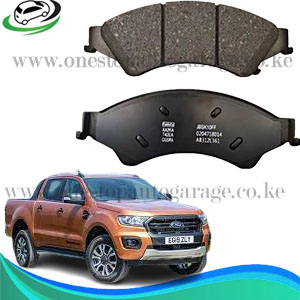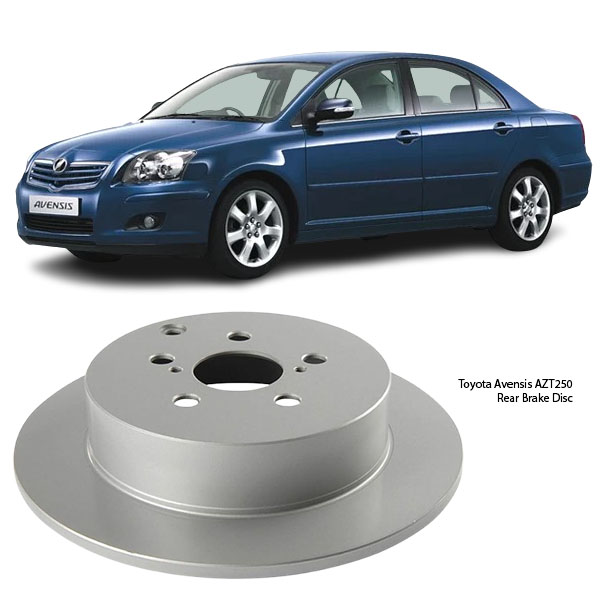-9%
Get Toyota Avensis AZT250 Rear Brake Disc 42431-05030 in Kenya
The rear brake disc is a critical part of the braking system found in modern vehicles, especially those equipped with disc brakes on all four wheels. It is a circular metal disc mounted to the wheel hub, rotating along with the wheel. When you apply the brakes, the brake pads clamp down on the disc, using friction to slow or stop the vehicle.
Although front brake discs handle a larger share of the braking load due to weight transfer during deceleration, the rear brake discs play a supporting but essential role in maintaining stability and balanced stopping power.
History and Evolution of Rear Brake Discs 📜
Earlier vehicles relied primarily on drum brakes at the rear, but over the years, as vehicles got faster and heavier, rear disc brakes became more common. Disc brakes offer better cooling, improved stopping power, and more precise braking control compared to drum brakes. Today, almost all performance vehicles, SUVs, and modern cars use rear brake discs for superior braking performance.
Key Functions of Rear Brake Discs 🛠️
1. Slowing the Vehicle ⏬
The primary job of the rear brake disc is to help stop the rear wheels. When brake pads squeeze the disc, friction converts kinetic energy into heat, slowing the wheel.
2. Stability and Balance ⚖️
During braking, weight shifts to the front of the car. The rear brakes help prevent the vehicle’s rear end from lifting excessively, ensuring stability — especially when braking in corners.
3. Parking Brake Function ⚙️
In some vehicles, the parking brake engages the rear brake discs (through a mechanical system), holding the vehicle in place when parked.
How Rear Brake Discs Work ⚙️🔗
Here’s a simple step-by-step breakdown:
- You press the brake pedal.
- Hydraulic fluid transfers pressure to the rear brake calipers.
- The calipers squeeze the brake pads against the spinning rear brake disc.
- Friction slows the rotation of the disc, thus slowing the wheel.
- The heat generated during braking dissipates into the air.
Materials Used in Rear Brake Discs 🔩
Rear brake discs must be durable, heat-resistant, and capable of handling repeated friction. Common materials include:
1. Cast Iron 🪨
- Affordable and widely used.
- Good heat capacity.
- Prone to rust if not coated.
2. Carbon-Ceramic 🏎️
- Found in high-performance vehicles.
- Extremely lightweight and heat-resistant.
- Very expensive.
3. Composite Discs ⚒️
- Combine different materials like iron, aluminum, and carbon for optimal performance.
- Used in modern high-performance SUVs and luxury vehicles.
Types of Rear Brake Discs 🛠️
1. Solid Discs ⭕
- Basic design with a single solid piece.
- Found in smaller or economy cars.
- Suitable for lighter loads.
2. Vented Discs 🌬️
- Contain internal cooling channels.
- Better at dissipating heat.
- Common in larger or performance vehicles.
3. Drilled Discs 🕳️
- Feature holes drilled through the disc.
- Improve cooling and water dispersion.
- Often seen on sports cars.
4. Slotted Discs 🌀
- Have grooves cut into the surface.
- Helps remove debris, gases, and water.
- Improves bite, especially in wet conditions.
Benefits of Rear Brake Discs ✅
1. Better Cooling 🌡️
Discs are exposed to airflow, meaning they cool much faster than enclosed drum brakes.
2. More Consistent Performance 💪
Even during repeated hard braking, rear discs maintain better stopping power compared to drums, which can overheat and fade.
3. Easier Maintenance 🔧
Replacing discs and pads is simpler and faster than servicing drum brake systems.
Common Problems with Rear Brake Discs ⚠️
1. Warping 🔥
Excessive heat or improper torque when fitting wheels can cause disc warping, leading to vibration when braking.
2. Scoring and Grooving 🛠️
Over time, debris caught between the pad and disc can scratch the surface, reducing braking effectiveness.
3. Corrosion and Rust 🌧️
If the vehicle sits unused for long periods, rust can form, especially on untreated cast iron discs.
4. Uneven Wear ⛔
If calipers don’t apply equal pressure, one side of the disc may wear faster than the other.
Maintenance Tips for Rear Brake Discs 🧰
-
Inspect Regularly 👀
Check for scoring, cracks, or rust during routine service. -
Replace in Pairs ⚙️⚙️
Always replace both rear discs together to maintain balanced braking. -
Check Pad Condition 🧼
Worn pads damage the disc faster. Always replace pads when they hit the wear limit. -
Avoid Excessive Heat 🔥
Avoid prolonged hard braking, especially when towing or descending long hills. -
Keep Surfaces Clean 🧽
Avoid getting oil or grease on the braking surface during service.
Signs Your Rear Brake Discs Need Replacing 🚨
- Squealing or grinding noises.
- Vibration when braking.
- Reduced braking power.
- Deep grooves or visible cracks.
- Dashboard brake warning light (in some vehicles).
Rear Brake Discs vs. Rear Drum Brakes 🔄
| Feature | Rear Brake Discs 🚗 | Rear Drum Brakes 🚙 |
|---|---|---|
| Cooling | Excellent 🌬️ | Poor 🌡️ |
| Maintenance | Easier ⚙️ | More complex 🔧 |
| Performance | Consistent ✅ | Fades under heat ❌ |
| Cost | Higher 💰 | Lower 💵 |
| Use Case | Most modern vehicles 🌍 | Older & economy vehicles 📦 |
Importance of Quality Rear Brake Discs ⭐
Using high-quality discs from trusted brands ensures:
- Better braking performance.
- Longer lifespan.
- Reduced risk of warping and noise.
- Safer driving.
Environmental Impact 🌍
Brake disc wear generates fine dust particles, contributing to airborne pollution. This is why eco-friendly materials and improved pad compounds are being developed to reduce the environmental footprint.
Final Thoughts 🏁
The rear brake disc may not receive as much attention as its front counterpart, but it plays a vital role in vehicle safety, balance, and braking efficiency. Understanding its function, types, benefits, and maintenance requirements helps you keep your vehicle safe and performing at its best.
Next time you hear a brake noise or feel vibration from the rear, don’t ignore it — your rear brake discs might be calling for attention. Regular checks and quality replacements ensure you stop with confidence every time you hit the brake pedal.
Follow us on Facebook for more parts.



